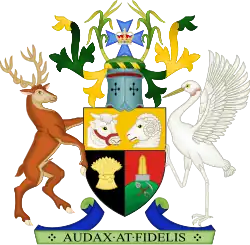Parliament of Queensland
Parliament of Queensland | |
|---|---|
| 58th Parliament | |
 | |
| Type | |
| Type | |
| Houses | Legislative Assembly |
| Sovereign | King (represented by the governor of Queensland) |
| History | |
| Founded | 22 May 1860 |
| Leadership | |
Charles III since 8 September 2022 | |
Jeannette Young since 1 November 2021 | |
| Structure | |
| Seats | 93 |
 | |
Political groups | Government (52)
Opposition (35)
Crossbench (5)
|
| Elections | |
| Full preferential voting | |
Last election | 26 October 2024 |
Next election | October 2028 |
| Meeting place | |
 | |
| Parliament House, Brisbane, Queensland, Australia | |
| Website | |
| parliament.qld.gov.au | |
| Constitution | |
| Constitution of Queensland | |
The Parliament of Queensland is the unicameral legislative body of the Australian state of Queensland. As provided under the Constitution of Queensland, the Parliament consists of the King, represented by the Governor of Queensland, and the Legislative Assembly. It has been the only unicameral state legislature in the country since the upper chamber, the Legislative Council, was abolished in 1922. The Legislative Assembly sits in Parliament House in the state capital, Brisbane.
The Queensland Parliament retains plenary legislative power over Queensland, however Commonwealth laws apply to the extent of any inconsistency. Some laws from the colonial era passed by the New South Wales parliament and the Imperial Parliament also remain in force.[1]
Following the outcome of the 2015 election, four additional seats were added to the Legislative Assembly (to a total of 93), the voting system changed from optional preferential voting to full-preferential voting, and unfixed three-year terms were replaced with fixed four-year terms.[2]
History
The Parliament was founded 22 May 1860, less than a year after the Colony of Queensland was created in June 1859.[3] It was convened at military and convict barracks converted for the purpose located on Queen Street, Brisbane.[4] Immigration was an important issue for the early Parliament. Population growth was encouraged with new settlers enticed by land ownership.[5]
In 1915, Queensland became the first state to make voting compulsory at state elections.[6]
Since 1 April 2003, live audio broadcasts have streamed through the internet from the Parliament while it is in session.[7] In June 2007, the Parliament started broadcasting video of parliamentary proceedings. Nine in-house television cameras are used to record sessions.[8]
The first female Speaker, Fiona Simpson was elected on 15 May 2012.[9]
Membership
The Assembly has 93 members of Parliament (MPs). These are intended to represent approximately the same population in each electorate. Voting is by the full preferential voting system, with elections held every four years.
In April 2016, legislation was passed to increase the number of seats in the parliament by four to a total of 93. An amendment was also passed to abolish optional preferential voting. A referendum held the previous month was passed, supporting a bill to establish fixed four-year terms.
Royal assent
.png)
The role of the monarch in Parliament is to give royal assent to legislation. This function is in practice exercised by the governor of Queensland, who conventionally will never refuse assent to a bill that has passed the Legislative Assembly. The party or coalition with the most seats in the house is invited by the governor to form a government.
The leader of that party subsequently becomes the premier of Queensland, leading a Cabinet of ministers. In the Liberal National Party, the premier selects members of their party to act as ministers. In the Labor Party, the ministers are elected by party room ballot, with the leader then assigning ministerial portfolios to each one.
Operations
Once all winning candidates have been declared, the governor of Queensland proclaims a date for the start of the new Parliament.[10] It is the role of the Clerk of the Parliament to call members to attendance.
According to the Constitution of Queensland, members of Parliament must swear an oath or affirmation to the King as well as an oath of office before signing a Roll of Members.[10][11] This oath or affirmation must be made to the governor or someone authorised by him or her—typically the clerk of the Parliament.

Sworn-in representatives are required to elect a Speaker to preside over the House's business.[10] Before this occurs, the longest serving member who is not a minister presides over the procedings.[12] Once elected the Speaker is dragged to the chair and presented to the Governor at Government House.[10] The symbol of the authority of the Parliament and its Speaker is the ceremonial mace. The sergeant-at-arms carries the mace into the chamber of parliament when the speaker enters at the start of each sitting day and removes it again when the speaker leaves at the end of the sitting day. During the sitting day, the mace rests on two raised brackets on the centre table with the head of the mace lying pointed towards the government's side. The current mace was designed and made in 1978 and is sterling silver with gold plating and is encrusted with 32 Queensland gemstones.[13] Despite being the symbol of Parliament, it is engraved with the words "Government of Queensland".
The ceremonial opening of the new Parliament is marked by a speech by the governor. Traditionally the speech is written by the new government and it may outline current activities, budget details, statistics and proposed lists of legislation which are intended to be introduced.[10]
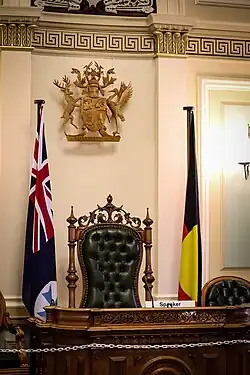
A day in Parliament usually begins with housekeeping matters, including prayers, notifications and the tabling of any documents.[10] An opportunity is then given to Ministers to make statements. During a period of no more than an hour, known as question time, any member may pose a question to a Minister.
Regional sittings
Starting in 2002, the Queensland Parliament has held regional sittings of parliament across the state.[14] Originally being held every three years, the occurrence has become more sporadic. The most recent was in 2023 in Cairns, the first regional sitting since the COVID-19 pandemic.
| No. | Location | Dates | Venue | Region |
|---|---|---|---|---|
| 1 | Townsville | 3–5 September 2002 | Townsville Entertainment and Convention Centre | North Queensland |
| 2 | Rockhampton | 4–6 October 2005 | Pilbeam Theatre | Central Queensland |
| 3 | Cairns | 28–30 October 2008 | Cairns Convention Centre | Far North Queensland |
| 4 | Mackay | 24–26 May 2011 | Mackay Entertainment and Convention Centre | Mackay, Isaac and Whitsunday |
| 5 | Townsville | 3–5 September 2019 | Townsville Entertainment and Convention Centre | North Queensland |
| 6 | Cairns | 9–11 May 2023 | Cairns Convention Centre | Far North Queensland |
Distribution of seats
As of 13 September 2024, the composition of Parliament is:
| Party | Seats | ||
|---|---|---|---|
| Current Assembly (total 93 seats) | |||
| Liberal National | 52 | ||
| Labor | 36 | ||
| Katter's Australian | 3 | ||
| Greens | 1 | ||
| Independent | 1 | ||
- 47 votes as a majority are required to pass legislation.
Longest-serving members
Members of the Queensland Legislative Assembly (directly-elected) who served over 30 years.
| Name | Photo | Party | Chamber | Start of tenure | End of tenure | Period of service | |
|---|---|---|---|---|---|---|---|
| James Larcombe | 
|
Labor | Legislative Assembly | 27 April 1912 | 11 May 1929 | 41 years, 1 day | |
| 11 June 1932 | 19 May 1956 | ||||||
| Sir Joh Bjelke-Petersen | 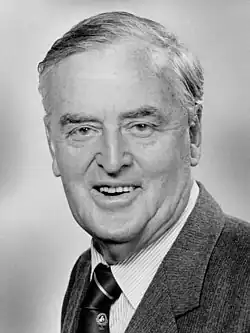
|
Country | Legislative Assembly | 3 May 1947 | 1 December 1987 | 40 years, 212 days | |
| Thomas Foley | Labor | Legislative Assembly | 20 December 1919 | 28 May 1960 | 40 years, 160 days | ||
| Harry Walker | 
|
Country | Legislative Assembly | 18 May 1907 | 3 May 1947 | 39 years, 350 days | |
| William Groom | .jpg)
|
Protectionist | Legislative Assembly | 11 August 1862 | 4 June 1901 | 38 years, 297 days | |
| Sir Frank Nicklin | 
|
Country | Legislative Assembly | 11 June 1932 | 13 February 1968 | 35 years, 247 days | |
| Alf Muller | 
|
Country | Legislative Assembly | 11 May 1935 | 17 May 1969 | 34 years, 6 days | |
| George Barber | 
|
Labor | Legislative Assembly | 6 July 1901 | 10 May 1935 | 33 years, 308 days | |
| Tom Aikens | 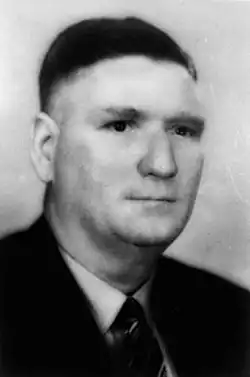
|
North Qld Labor | Legislative Assembly | 15 April 1944 | 12 November 1977 | 33 years, 211 days | |
| Johnno Mann | 
|
Labor | Legislative Assembly | 4 April 1936 | 17 May 1969 | 33 years, 43 days | |
| Andrew Petrie | 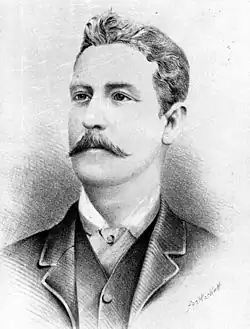
|
Ministerialist | Legislative Assembly | 29 April 1893 | 8 May 1926 | 33 years, 9 days | |
| Fiona Simpson | LNP | Legislative Assembly | 19 September 1992 | present | 32 years, 332 days | ||
| Jack Duggan | 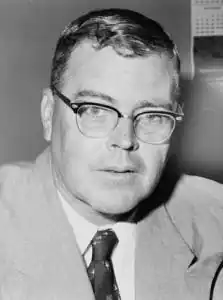
|
Labor | Legislative Assembly | 14 December 1935 | 3 August 1957 | 32 years, 227 days | |
| 31 May 1958 | 17 May 1969 | ||||||
| Sir William Knox | Liberal | Legislative Assembly | 3 August 1957 | 2 December 1989 | 32 years, 121 days | ||
| Thomas Dunstan | n/a | Labor | Legislative Assembly | 22 May 1915 | 11 May 1929 | 31 years, 301 days | |
| 11 May 1935 | 7 March 1953 | ||||||
| Ted Walsh | 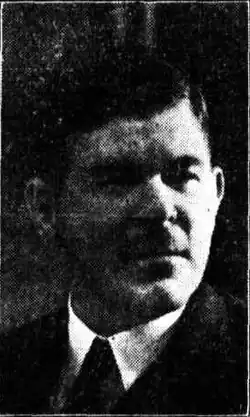
|
Labor | Legislative Assembly | 11 May 1935 | 3 May 1947 | 31 years, 18 days | |
| 29 April 1950 | 17 May 1969 | ||||||
| Frank Cooper | .jpg)
|
Labor | Legislative Assembly | 22 May 1915 | 12 March 1946 | 30 years, 294 days | |
Members of the nominated Queensland Legislative Council who served over 30 years.
| Name | Photo | Party | Chamber | Start of tenure | End of tenure | Period of service | |
|---|---|---|---|---|---|---|---|
| James Cowlishaw | 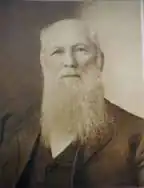
|
Independent | Legislative Council | 18 April 1878 | 23 March 1922 | 43 years, 339 days | |
| Frederick Hart | Independent | Legislative Council | 11 July 1872 | 15 July 1915 | 43 years, 4 days | ||
| James Lalor | 
|
Independent | Legislative Assembly | 5 December 1878 | 12 May 1888 | 42 years, 156 days | |
| Legislative Council | 23 August 1888 | 11 August 1921 | |||||
| John Heussler | 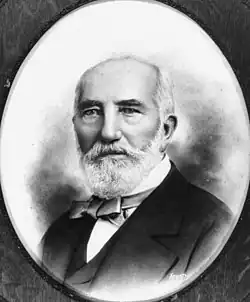
|
Independent | Legislative Council | 26 September 1866 | 8 October 1870 | 40 years, 338 days | |
| 13 December 1870 | 26 October 1907 | ||||||
| Andrew Thynne | 
|
Independent | Legislative Council | 26 January 1882 | 23 March 1922 | 40 years, 56 days | |
| William Taylor | 
|
Independent | Legislative Council | 17 April 1886 | 23 March 1922 | 35 years, 340 days | |
| Frederick Brentnall | Independent | Legislative Council | 17 April 1886 | 23 March 1922 | 35 years, 340 days | ||
| John McDougall | 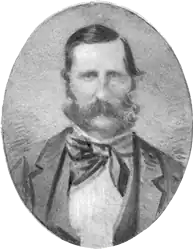
|
Independent | Legislative Council | 1 May 1860 | 13 September 1895 | 35 years, 135 days | |
| Dr Charles Marks | 
|
Independent | Legislative Council | 28 November 1888 | 6 January 1892 | 33 years, 57 days | |
| 11 March 1892 | 23 March 1922 | ||||||
| Peter MacPherson | Independent | Legislative Council | 1 July 1881 | 12 September 1913 | 32 years, 73 days | ||
See also
- Parliaments of the Australian states and territories
- Legislative Assembly of Queensland
- List of members of the Queensland Legislative Assembly
References
- ^ "The power of the Parliament of Queensland". Legislation Handbook. Department of the Premier and Cabinet. 23 April 2012. Archived from the original on 18 February 2013. Retrieved 5 January 2013.
- ^ Green, Antony (21 April 2016). "Electoral Law Ructions in the Queensland Parliament". Archived from the original on 8 December 2016. Retrieved 20 January 2021.
- ^ "Almost 150 years strong" (lift out section). The Courier-Mail. 28 August 2007. pp. 40 to 41.
- ^ "About Us". Queensland Parliament. Archived from the original on 28 April 2013. Retrieved 3 January 2013.
- ^ "Creation of a state". Government of Queensland. 30 July 2012. Archived from the original on 18 November 2012. Retrieved 3 January 2013.
- ^ Tony Moore (3 January 2013). "Compulsory confusion at the ballot box". Brisbane Times. Fairfax Media. Archived from the original on 5 January 2013. Retrieved 3 January 2013.
- ^ "Qld parliament goes live on the internet". The Sydney Morning Herald. 1 April 2003. Archived from the original on 28 February 2005. Retrieved 3 January 2013.
- ^ "Parliament accused of censorship over camera ban". Brisbane Times. Fairfax Media. 30 May 2008. Archived from the original on 11 March 2016. Retrieved 3 January 2013.
- ^ Daniel Hurst (15 May 2012). "Simpson elected state's first female Speaker as Parliament resumes". Brisbane Times. Fairfax MEdia. Archived from the original on 19 February 2024. Retrieved 5 January 2013.
- ^ a b c d e f Wanna, John; Tracey Arklay (2010). The Ayes Have It: The History of the Queensland Parliament 1957–1989 (PDF). ANU E Press. pp. 12–15. ISBN 978-1921666315. Archived (PDF) from the original on 21 January 2022. Retrieved 22 February 2021.
- ^ Constitution of Queensland 2001 (Qld) s 22
- ^ "Opening of Parliament" (PDF). Queensland Parliament. October 2024. p. 3. Retrieved 16 December 2024.
The Clerk calls upon the longest continuously serving member who is not a minister, to take the chair as the presiding member.
- ^ "Information on Parliament". Queensland Parliament. Archived from the original on 13 March 2023. Retrieved 19 February 2024.
- ^ "Regional Sittings". parliament.qld.gov.au. Parliament of Queensland. Archived from the original on 17 May 2023. Retrieved 17 May 2023.
Further reading
- Wanna, John; Tracey Arklay (2010). The Ayes Have It: The History of the Queensland Parliament 1957–1989 (PDF). ANU E Press. ISBN 978-1921666315.
- Queensland Parliamentary Procedures Handbook (PDF). Parliament of Queensland. February 2024.
External links
